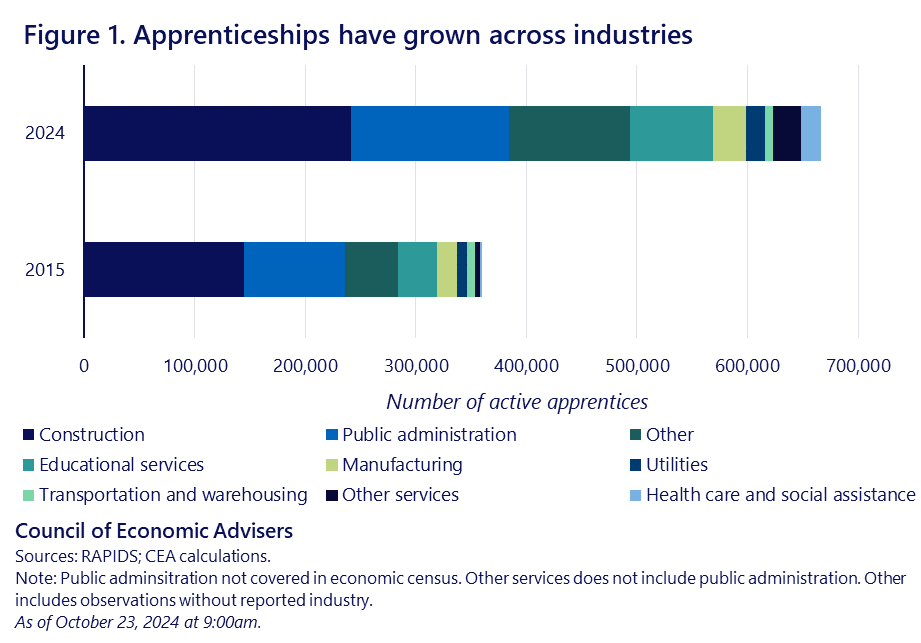All Aboard the ApprenticeSHIP: Assessing the Changing Face of Registered Apprenticeships
Registered Apprenticeships are a powerful pathway for building the skills needed in the economy of today and the future. However, apprenticeships have historically had a relatively narrow range of application in the United States. Elsewhere, they are more common: for example, in Switzerland, Germany, and Austria as many as 70 percent of youth begin their careers as apprentices.
The story in the U.S. is changing as active Registered Apprenticeships have risen sharply from about 360,000 in 2015 to over 667,000 in 2024.[1] Today, a wider variety of industries and demographic groups are participating than in the past.
Building on detailed data from Registered Apprenticeships throughout the country, CEA finds that apprenticeships have grown across industries and become more demographically diverse. Evaluations of Registered Apprenticeships repeatedly find that they are associated with a large wage premium for their participants. This year, the Biden-Harris Administration’s Registered Apprenticeship Executive Order and Good Jobs Executive Order aim to extend this model so that it can help more workers achieve their career goals and employers train the skilled workforce they need.
What is a Registered Apprenticeship and who are the apprentices?
A Registered Apprenticeship is a paid, on-the-job learning experience that meets certain industry-vetted standards. Among other things, those standards include a formal agreement between the apprentice and the “sponsor” (an employer, union, or other training provider), a minimum amount of documented on-the-job training, wage increases over time, and a recognized credential that is earned upon completion. Apprenticeships tend to last 2 to 5 years, financially supported by employers (which pay apprentice wages) and, in some cases, by unions and federal, state, and local workforce funds.
Historically, Registered Apprenticeships have tended to be concentrated in the building trades: electricians, carpenters, and plumbers are among the most common occupations. In 2015, the construction industry accounted for at least 40% of all active apprentices.[2] By 2024, other industries like educational services and health care/social assistance had increasingly featured in the world of Registered Apprenticeship, as shown in Figure 1. For example, in early 2021 there were no Registered Apprenticeship programs for K-12 teachers, but by late 2024 46 states (plus Puerto Rico and the District of Columbia) featured such programs.

Multiple federal and state efforts have aimed to expand the reach of Registered Apprenticeships to occupations and people who had tended not to enter them in the past. For example, broadening the apprenticeship model beyond the trades, and to underrepresented groups, was the aim of the 2015 American Apprenticeship Initiative. Since then, the Biden-Harris Administration has continued to invest in expanding, modernizing, and diversifying Registered Apprenticeship programs that enable workers to find a reliable pathway to the middle class.
The data show that Registered Apprenticeships have indeed become more demographically inclusive. In particular, the share of women among active apprentices has risen from 8.7% in 2015 to 14.5% in 2024, as shown in Figure 2. The diversification of industry mix, discussed above, accounts for about one third of the increase in women’s participation from 2015 to 2024. The remainder of the increase is due to women apprentices gaining substantial ground within industries, like construction, many of which have long featured apprenticeships.[3]

Apprentices have also become more racially and ethnically diverse. Asian, Black, and Latino workers have increased their shares of active apprenticeships from 2015 to 2024. Starting from relatively low levels of participation, these groups have experienced rapid growth since 2015: Asian, Black, and Latino apprenticeships grew by 100%, 92%, and 160%, respectively, compared to 79% growth for White apprenticeships.
What do we know about apprentices’ outcomes?
programs. Walton, Gardiner, and Barnow (2022) tracked participant earnings before and after their American Apprenticeship Initiative programs, finding that annual earnings rose by 49% after expected program completion.
Looking at different participant groups, the researchers found that women experienced larger earnings growth (65%) than men (43%). Katz and Shakesprere (2022) refine this type of analysis by comparing apprentice earnings growth to that of matched non-apprentices, finding substantially faster wage growth for apprentices (43%) than their counterparts (16%).[4] Compared to most other labor market interventions, these are very large earnings increases.
Making more and better use of Registered Apprenticeships
The Biden-Harris Administration has put apprenticeships at the core of its workforce strategy, investing nearly $730 million in Registered Apprenticeships. In addition to direct funding, the Inflation Reduction Act provided tax incentives to encourage use of Registered Apprenticeships for clean energy projects.[5] In March 2024, the Administration issued an executive order to accelerate use of registered apprenticeships in federal employment. Most recently, President Biden signed the Good Jobs Executive Order, which (among other things) directs federal agencies to support the apprenticeship model and outlines strategies for agencies to improve data collection. Making more and better use of apprenticeships is key to unlocking labor market opportunity and building a stronger economy.
[1] Throughout this blog, years refer to the fiscal year. The sample is limited to active apprentices.
[1] Industries are not recorded for all apprentices in our data, and we designate these within the “Other” category.
[3] This calculation is based on a Oaxaca-Blinder decomposition using 20 aggregated industries.
[4] See also Berger-Gross (2021) and Hollenbeck and Huang (2015).
[5] To receive the incentives, employers with four or more employees are required to use apprentices for a certain percent of total labor hours on supported construction sites. The required share of hours completed by qualified apprentices was 10 percent in 2022 and increased to 15 percent in 2024.
